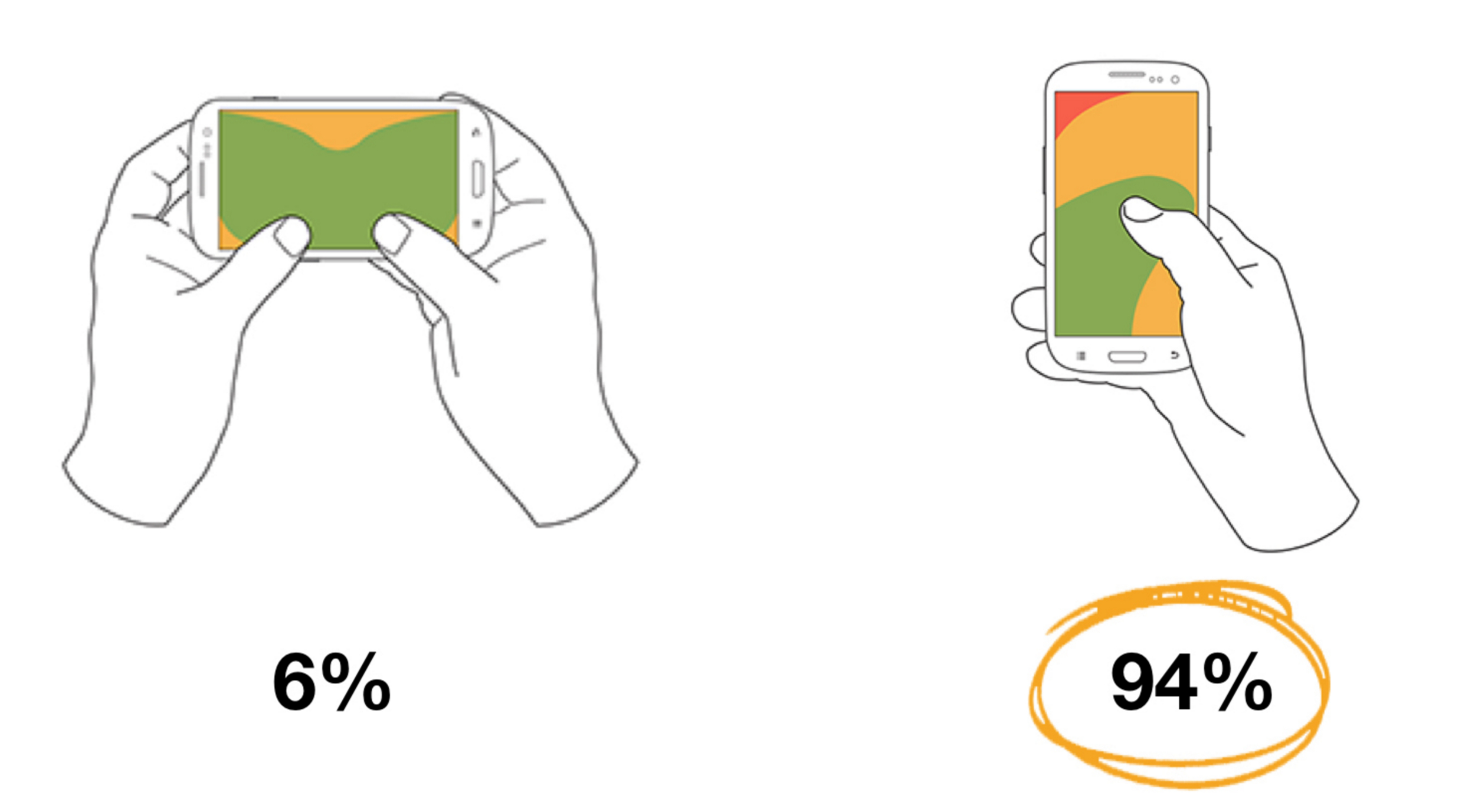5 Reasons Your Business MUST Start to Make Vertical Video For Social Media
/Does your business record vertical videos for social media? In years gone by, recording and uploading video with the camera held vertically was looked upon with ridicule - producing big black bars either side of the picture and a narrow viewing angle, guaranteed to turn viewers off - but times are changing. In this blog post, I'm going to lay out 5 reasons why your business should be experimenting with vertical video for social media marketing in 2017, and the benefits it can bring.
1. People naturally hold their phones vertically (duh!)
Obvious, but important! If we strip smartphones back to their most basic function - giving users the ability to make and receive phone calls - the design of modern smarphones simply follows the tradition of "dumb" phones from decades past; that the device should be held vertically so that the user can speak and listen with minimal fuss. TV and cinema, meanwhile, the dominant visual media for so long, have demanded that the picture is viewed horizontally for the best experience. And so, despite all the things smartphones can now do, we're historically conditioned to hold phones vertically and view video horizontally. We've been stuck between two competing worlds, but times are changing. For some hard facts, look to the MOVR Mobile Overview Report from December 2014, which found, unsuprisingly, that smartphone users hold their phones vertically about 94% of the time.
image credit: Form Meets Function http://formmeetsfunction.com/portfolio/vervid/
With the huge increase in mobile-recorded video content online in recent years, it's no surprise that vertical device usage also on the up. A 2016 study by KPCB Research showed that people in the US are now spending 29% of time using vertically-held devices, up from just 5% in 2010. And since people are holding these devices vertically for most tasks, it makes sense that they'll shoot video and play it back that way, too.
2. People access social media on mobile the most
Not only are the vast majority of mobile apps designed with the assumption that users will be interacting while holding their smartphone vertically, but its increasingly where people are spending their time on social media. In comScore’s 2016 U.S. Cross-Platform Future in Focus study, it showed that nearly 80% of social media use now occurs on mobile devices - 61% on smartphones alone. In addition, by 2018 in the US, the gap between desktop and mobile Internet use is predicted to grow to people spending three hours and 20 minutes using the Internet on their phone, compared to just 40 minutes on the computer. As a business, your content needs to be built in a way that caters best to how it is being consumed.
3. Social networks are vertical video-friendly
If we look at how vertical video renders on social apps, we see something interesting. As of February 2017:
- Facebook: vertical videos publish with no black borders.
- Instagram: vertical videos publish with no black borders.
- Snapchat: vertical videos publish with no black borders.
- Twitter: vertical videos publish with no black borders.
- YouTube: The Android version of the app hides black borders when device is held vertically and video is viewed in full screen.
Rather than looking upon vertical video as a negative, social networks - even YouTube - are embracing the format. There's no way they're going to be able force people to film in landscape mode without really annoying them(as YouTube used to do!), so why not make the viewing experience (inferior to landscape mode as it may be) as optimum as it can be? And there are other benefits. When it comes to watching live video, viewers holding their phones vertically can engage with reactions and comments in a way that is natural to them.
Rolling out the 2:3 ratio of vertical video on Facebook in August 2016 (rather than cropping vertical videos into squares), a Facebook representative told Marketing Land at the time: “We know that people enjoy more immersive experiences on Facebook, so we’re starting to display a larger portion of each vertical video in News Feed on mobile." Facebook wants people to stay on its site, so it will do whatever it can to suit their needs.
Instagram's roll-out of vertical video last year shared a similar sentiment. In a blog post to announce its Stories feature (boasting over 150 million users as of January 2017), it said: “Square format has been and always will be part of who we are. That said, the visual story you’re trying to tell should always come first, and we want to make it simple and fun for you to share moments the way you want to."
4. Vertical video ads convert better
Vertical video ads are growing in favour with advertisers as well, and when you understand that's how the orientation in which users are increasingly consuming video, you see why. "From a storytelling perspective, this is obviously more exciting," said Dan Grossman, VP of platform partnerships at VaynerMedia told Mashable. "If we can take up more of the screen that means you're less distracted. We can capture more of the viewer's attention."
In another recent development, the launch of vertical video ads for Instagram Stories in January 2017, it seemed open to their success: “Since the beginning, we’ve been thoughtful about rolling out ads on Instagram to give businesses and consumers the best experience possible. And ad formats are no exception. Portrait has long been available on the platform for posts, and is a common format for consuming mobile content”.
For more factual evidence, look to Snapchat, who you might say spearheaded the vertical video revolution in social media. In a pitch to publishers in 2015, it reported that full screen vertical video ad completion rates were 9x higher than those of horizontal video ads. The company's internal research also shows that vertical video ads draw up to 2x higher visual attention vs. comparable platforms - "Communicate your brand message in a way that fits your phone, the way Snapchatters actually use it."
In addition, Jason Stein, CEO of Laundry Service, reported success with LG vertical video ads soon after their launch last year. He told Adweek that his had had been receiving CPM rates that were 3x more efficient than standard square videos on Facebook.
5. Your customers are lazy
Whisper it, but it's true - and as customers ourselves, we're all guilty of it. Think of it like this: when users are zipping through mobile sites and social media feeds, they expect the experience to be seamless. If your video plays in landscape and can be viewed okay, not very many people are going to make the effort to turn their phone 90 degrees and tap to expand to full screen. It's lazy, but it's the truth. As a marketer, that means you're missing out on filling a users' screen with your ad and keeping their full attention as effectively as possible.
Perhaps this point is best summed up by Zena Barakat, a former New York Times video producer who spent a year researching vertical video. She discovered that many people didn’t reorient their phones to watch horizontal videos in full-screen mode. “As a person who makes videos, I was like, ‘You’re not seeing it the way we intended it!’” Ms. Barakat told the New York Times. “And they were like, ‘We don’t care!’ They found it so uncomfortable to hold the phone the other way, and they didn’t want to keep switching their phones back and forth.’”
Over to you
What are your thoughts on the vertical video revolution? Will you be experimenting with vertical video on social for your brand? Let me know in the comments below!
Andrew Macarthy is a social media consultant and the author of the #1 Amazon Web Marketing Bestseller, 500 Social Media Marketing Tips.
Buy 500 Social Media Marketing Tips
Amazon US: http://www.amazon.com/dp/B007L50HE6
Amazon UK: http://www.amazon.co.uk/dp/B007L50HE6
Follow Me:
http://www.facebook.com/500socialmediatips/
http://www.pinterest.com/andrewmacarthy
http://www.twitter.com/andrewmacarthy









